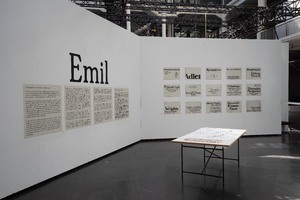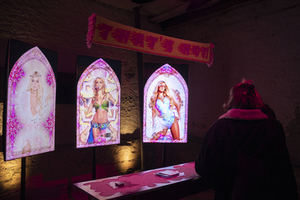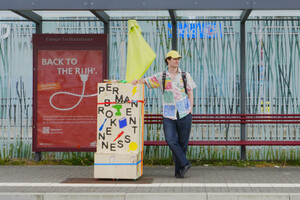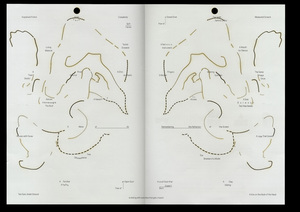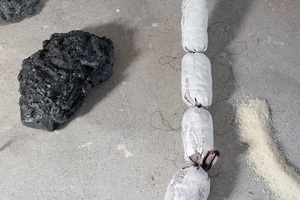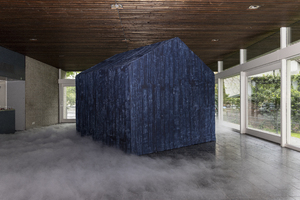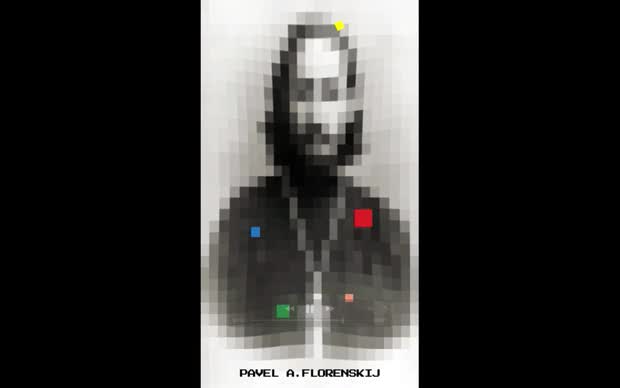The Plenum – A Scripted Play
Sibling sets (27)Show all relations
This set is related to the same sets as the selected set.
27 Items
- Page 1 of 3
Emil
- Title
- Emil
- Title (en)
- Emil
- Subtitle
- Typografie als Medium historischer Sichtbarkeit
- Subtitle of the project/work (en)
- A typographic revival reflecting historical erasure
- Author
- Description (de)
- „Emil” ist ein Diplomprojekt, das die Rolle der Typografie im Umgang mit Erinnerung, Verdrängung und historischen Brüchen untersucht. Im Mittelpunkt stehen die Lebens- und Werkgeschichten jüdischer Gestalter:innen während des Nationalsozialismus, darunter Elizabeth Friedländer und Lucian Bernhard (geb. Emil Kahn).
Ein zentrales Element des Projekts ist das Revival der Bernhard Antiqua von Lucian Bernhard. Die Schrift wurde für die zeitgenössische Nutzung digital neu interpretiert und prägt die gesamte visuelle Ebene des Projekts – von der Plakatserie über die Ausstellungsgestaltung bis hin zur Vortragspräsentation. So wird Typografie zum Untersuchungsgegenstand und zum gestalterischen Werkzeug der Erinnerung.
Für Julian Jaffé, Nachfahre einer jüdischen Familie, die im Nationalsozialismus ins Exil gezwungen wurde, ist "Emil" nicht nur ein typografisches Projekt, sondern auch ein persönlicher Akt des Erinnerns.
- „Emil” ist ein Diplomprojekt, das die Rolle der Typografie im Umgang mit Erinnerung, Verdrängung und historischen Brüchen untersucht. Im Mittelpunkt stehen die Lebens- und Werkgeschichten jüdischer Gestalter:innen während des Nationalsozialismus, darunter Elizabeth Friedländer und Lucian Bernhard (geb. Emil Kahn).
- Description (en)
- Emil is a diploma project that examines the role of typography in dealing with memory, repression and historical ruptures. It focuses on the lives and works of Jewish designers during National Socialism, including Elizabeth Friedländer and Lucian Bernhard (born Emil Kahn).
A central element of the project is the revival of Bernhard Antiqua by Lucian Bernhard. The font has been digitally reinterpreted for contemporary use and shapes the entire visual level of the project – from the poster series to the exhibition design and lecture presentation. In this way, typography becomes both the subject of investigation and a creative tool of remembrance.
For Julian Jaffé, a descendant of a Jewish family forced into exile during the Nazi era, ‘Emil’ is not only a typographic project, but also a personal act of remembrance.
- Emil is a diploma project that examines the role of typography in dealing with memory, repression and historical ruptures. It focuses on the lives and works of Jewish designers during National Socialism, including Elizabeth Friedländer and Lucian Bernhard (born Emil Kahn).
- Category
- Keywords
- Thanks to
- Technology/production/formats
- Typografie
- Title
- Emil
- Projektleiter/in
- Semester
- Program of Study
- Type of graduation project
- Imported on
- 26.06.2025
- Parent sets
- 0
- Set is related to
- 0 13
Manchmal ist Schmerz ganz leise
- Title
- Manchmal ist Schmerz ganz leise
- Title (en)
- Sometimes pain is very quiet
- Author
- Description (de)
- „Manchmal ist Schmerz ganz leise“ ist eine immersive, autobiographische Hörstück-Installation, die den stillen und oft unsichtbaren Kampf mit einer schweren, namenlosen Krankheit in den Mittelpunkt stellt. Das Werk hinterfragt, was es bedeutet, in einer leistungsorientierten Gesellschaft plötzlich nicht mehr zu "funktionieren". Es geht den Ängsten, der Scham und dem tief empfundenen Gefühl des Versagens nach, das oft mit chronischer Krankheit einhergeht – Gefühle, die Betroffene selten teilen. Das Hörspiel verleiht einer Stimme Ausdruck, die für viele spricht und Einblicke in eine Realität gibt, die oft im Verborgenen bleibt.
- Description (en)
- ‘Sometimes pain is very quiet’ is an immersive, autobiographical audio play installation that focuses on the silent and often invisible battle with a serious, nameless illness. The work questions what it means to suddenly no longer ‘function’ in a performance-orientated society. It explores the fears, the shame and the deeply felt sense of failure that often accompanies chronic illness - feelings that are rarely shared by those affected. The radio play gives expression to a voice that speaks for many and provides insights into a reality that often remains hidden.
- Category
- Type of project / creative work
- Keywords
- Date
- 30.10.2024
- Contributors
- Thanks to
- Finn Baygan
- Daniel Berwanger
- Pauline Cemeris
- Filipa Cesar
- Mark Patrick Damian
- Charlotte Eifler
- Flora Güldenpfennig
- Tobias Keilbach
- Eisenhart Keimeyer
- Alexander Knoppik
- Yael Kolb
- Isabelle Konrad
- Julian Kuf
- Barbara Kuon
- Josephine Leicht
- Laura Morcillo
- Ilja Morgenstern
- Sebastian Schäfer
- Sebastian Schönfeld
- Lorenz Schwarz
- Quirin Thalhammer
- Alexander Thelen
- Riemschneider Stiftung
- Zeitbild Lab
- Language
- Material
- Technology/production/formats
- 4-Kanal-Audio/360° Projection Mapping
- Dimensions
- Länge: 8m, Breite: 8m, Höhe: 6,50m
- Duration
- 30min
- Location: institution
- Location
- Großes Studio
- City
- Country
- Title
- Manchmal ist Schmerz ganz leise
- Projektleiter/in
- Semester
- Program of Study
- Type of graduation project
- Imported on
- 17.04.2025
- Parent sets
- 0
- Set is related to
- 1 5
Die Methode Duchamp – Magritte
- Title
- Die Methode Duchamp – Magritte
- Subtitle
- Das „Musée d’Art Moderne. Département des Aigles” von Marcel Broodthaers unter dem Aspekt der strategischen Aneignung
- Author
- Description (de)
- „Der Fall Marcel Broodthaers lädt den Rezipienten dazu ein, sich mit dessen Vorläufern auseinanderzusetzen. Nicht etwa, weil dort Geheimnisse aufzudecken wären – im Gegenteil, die broodthaers’schen Galionsfiguren sind in seinem Werk alle namentlich präsentiert –, sondern eher auf Grund der Tatsache, da er es wie kaum ein anderer verstanden hat, sich bestimmter Vorbilder zu bedienen, sprich, sich Teilaspekte aus deren Werken anzueignen und die darin enthaltenen Kerngedanken eigens fortzuschreiben. Dies geschieht auf eine Art und Weise, die es vermag, Hommage und Kritik zu vereinen.”
„Über zwei Doppelseiten hinweg breitet sich im Ausstellungskatalog zur Section des Figures [...] das graphisch aus, was Broodthaers als seine METHODE tituliert. Diese Blätter folgen in direktem Anschluß an das Vorwort, sie markieren den Anfang zu jenem Katalogteil, der sowohl inhaltlich, als auch formal maßgeblich vom Künstler gestaltet worden ist. Bereits die Typographie des Titelworts strahlt – in Majuskel gesetzt – eine hohe Wichtigkeit aus. Wer allerdings ausführliche Erläuterung erwartet hat, wird enttäuscht, es handelt sich vielmehr um eine anspielungsreiche Illustration als um eine schriftliche Erklärung, doch gleichwohl trägt diese Ausführung den Charakter des Manifests.”
- „Der Fall Marcel Broodthaers lädt den Rezipienten dazu ein, sich mit dessen Vorläufern auseinanderzusetzen. Nicht etwa, weil dort Geheimnisse aufzudecken wären – im Gegenteil, die broodthaers’schen Galionsfiguren sind in seinem Werk alle namentlich präsentiert –, sondern eher auf Grund der Tatsache, da er es wie kaum ein anderer verstanden hat, sich bestimmter Vorbilder zu bedienen, sprich, sich Teilaspekte aus deren Werken anzueignen und die darin enthaltenen Kerngedanken eigens fortzuschreiben. Dies geschieht auf eine Art und Weise, die es vermag, Hommage und Kritik zu vereinen.”
- Description (en)
- "The case of Marcel Broodthaers invites the recipient to engage with his precursors. Not because there are secrets to be uncovered there - on the contrary, Broodthaers' figureheads are all presented by name in his work - but rather due to the fact that he understood better than almost anyone else how to make use of certain role models, i.e. to appropriate partial aspects from their works and to continue the core ideas contained therein in his own way. This is done in a way that manages to combine homage and criticism."
"Over two double-page spreads in the exhibition catalogue for Section des Figures [...] Broodthaers' METHOD is presented graphically. These pages follow directly after the preface and mark the beginning of the section of the catalogue that was designed by the artist both in terms of content and form. Even the typography of the title word - set in majuscule - radiates great importance. However, anyone expecting a detailed explanation will be disappointed; it is more of an allusive illustration than a written explanation, but this version nevertheless has the character of a manifesto."
- "The case of Marcel Broodthaers invites the recipient to engage with his precursors. Not because there are secrets to be uncovered there - on the contrary, Broodthaers' figureheads are all presented by name in his work - but rather due to the fact that he understood better than almost anyone else how to make use of certain role models, i.e. to appropriate partial aspects from their works and to continue the core ideas contained therein in his own way. This is done in a way that manages to combine homage and criticism."
- Category
- Keywords
- Date
- November 2010
- Language
- Location: institution
- Title
- Die Methode Duchamp – Magritte
- Semester
- Archive signature
- HfG HS 2010 09
- External archive
- Imported on
- 10.01.2025
- Parent sets
- 1
- Set is related to
- 0 2
'all the good girls go to hell' – Zur Widerständigkeit in der Figur der Hexe
- Title
- 'all the good girls go to hell' – Zur Widerständigkeit in der Figur der Hexe
- Author
- Description (de)
- In der Magisterarbeit „all the good girls go to hell – Zur Widerständigkeit in der Figur der Hexe“ untersucht Louisa Raspé den Begriff der Hexe und die in der Figur existierende Ambivalenz. Ausgehend von der Unterscheidung von der „Hexe“ als negative Fremdbezeichnung und der »Hexe« als positive Selbstbezeichnung, sowie der damit zusammenhängenden Machtaspekte, beschäftigt sich diese Arbeit mit der Frage nach Subjektkonstruktionen und den Subjekten der Geschichtsschreibung im Gegensatz zu Erzählungen. Es geht um die Hexe als Figur der Übergänge und Grenzüberschreitungen, sowie ihren Beitrag zu gesellschaftlichen, kulturellen und politischen Umbrüchen im westeuropäischen Kontext. In dieser Arbeit geht es darum eine kritische Perspektive auf die Konstruktion von Subjekt, Geschlecht und Macht einzunehmen und stellt zugleich die Frage, wie sich Widerständigkeit im Spannungsfeld zwischen Stigma und Empowerment ausdrücken lässt.
- Category
- Keywords
- Thanks to
- Language
- Location: institution
- Title
- 'all the good girls go to hell' – Zur Widerständigkeit in der Figur der Hexe
- Projektleiter/in
- Semester
- Program of Study
- Type of graduation project
- Imported on
- 06.12.2024
- Parent sets
- 0
- Set is related to
- 0 0
Cooking Care
- Title
- Cooking Care
- Author
- Description (de)
- Welche Art von unbezahlter Sorgearbeit leistest du?
Fühlst du dich dafür wertgeschätzt?
Würdest du dir mehr Hilfe von Familienmitgliedern oder Freund*innen wünschen?
Die szenische Installation „Cooking Care“ zeigt eine pflanzen gefärbte Patchwork-Tischdecke, die die Geschichten von Valeria, Susanne, Anna, Heike und Anne und deren unbezahlten Sorgearbeit über eine Woche hinweg in sich aufgesogen hat. Sie möchte die unsichtbare Arbeit sichtbar machen, investierte Zeit würdigen und sie feiern. Sie bietet eine Bühne, um ihre Stimmen zu hören, Verbindungen zu knüpfen und sich gegenseitig zu unterstützen.
Ausgangspunkt dieses Projekts war ein Abendessen mit fünf Frauen, die in verschiedenen Bereichen der unbezahlten Sorgearbeit tätig sind. An diesem Abend war das Kochen eine gemeinsame Aufgabe, die es allen ermöglichte, nicht nur den Prozess und das gemeinsame Essen zu genießen, sondern auch sich umeinder zu sorgen. Es wurde eine Reihe von vorbereiteten Fragen gestellt, um einen Raum für den Austausch von Geschichten, Zweifeln und Erfahrungen zu schaffen.
Darüber hinaus wurden die Teilnehmer ermutigt, die Stunden unbezahlter Sorgearbeit, die sie in den nächsten sieben Tagen leisteten, zu dokumentieren; sie sollten konkrete Zahlen auf Papier bringen, um die Stunden sowohl für sich selbst als auch für andere sichtbar zu machen. Sie wurden auch gebeten, die psychische Belastung zu dokumentieren, die sie in dieser Zeit erfahren haben. Anschließend wurden die dokumentierten Stunden unterschiedlicher Sorgearbeit und die entsprechende psychische Belastung in eine abstrakte Infografik – in Form einer Tischdecke – übersetzt.
Die Tischdecke besteht aus mehreren gleich großen Quadraten, die jeweils eine Stunde unbezahlter Pflegearbeit repräsentieren, die von diesen fünf Frauen im Laufe der sieben Tagen dokumentiert wurde. Die einzelnen Stoffstücke wurden mit essbaren, saisonalen und lokal beschafften Pflanzen gefärbt, von denen viele selbst gesammelt wurden. Sie wurden vorbehandelt und 24 bis 48 Stunden lang im Färbebad gekocht. Da es sich bei den Stoffen um gebrauchte Haushaltstextilien handelt, hat jedes Stück seine eigene Geschichte und variiert in seiner Fähigkeit, Farbe zu absorbieren. Daher war der Färbeprozess experimentell und variierte, was jedes Mal zu einem einzigartigen Ergebnis führte. Außerdem trug der unterschiedliche Wuchs der zum Färben verwendeten Pflanzen zur Vielfalt der Ergebnisse bei.
Jede gefärbte Farbnuance steht für eine andere Art von Pflegearbeit. Bei hoher psychischer Belastung wurden die Quadrate mit zusätzlichem Stoff durch die Quilting Technik verdickt. Die so entstandene Tischdecke dient somit als künstlerische Abstraktion der unbezahlten Sorgearbeit, die ihre Sichtbarkeit erhöhen soll.
- Welche Art von unbezahlter Sorgearbeit leistest du?
- Description (en)
- What kind of unpaid care work are you doing?
Do you feel appreciated for it?
Would you like to have more help from family members or friends?
The spatial installation 'Cooking Care' shows a plant-dyed patchwork tablecloth soaked in the stories of Valeria, Susanne, Anna, Heike und Anne and their unpaid care-workload of one week. It aims to reach visibility, to celebrate, and appreciate the time and effort put into that work, and to give their voices a stage to be heard, connected and empowered.
The starting point of this project was a dinner with five women who engage in different fields of unpaid care work. That evening, cooking was a shared task, allowing everyone to not only enjoy the process and feasting together but also to care for each other. A set of premeditated question was asked to create a space to share stories, doubts, and experiences.
Furthermore, the participants were encouraged to document the hours of unpaid care work they performed over the next seven days; to provide actual numbers on paper, making it visible both to themselves and to others. They were also asked to document the mental load they experienced during this time. Then, the documented hours of different care work and the according mental load were translated into an abstract infographic in the form of a tablecloth.
The tablecloth consists of multiple squares of identical size each representing one hour of unpaid care work as documented by these five women over the course of seven days. The individual fabric pieces have been dyed using edible, seasonal, and locally-sourced plants, many of which were self-collected. They were pre-treated and cooked in the dye bath for 24 to 48 hours. Since the fabric consists of second hand household textiles, each piece carries its own history and varies in its ability to absorb dye. Thus, the dyeing process was experimental and varied with each batch, resulting in a unique outcome every time. The different growth of the plants used for dyeing added to the variety.
Each dyed color shade stands for a different type of care work. When there was a high mental load reported, squares were also thickened with additional fabric by the quilting technique. The resulting tablecloth thus serves as an artistic abstraction of the unpaid care work that aims to increase its visibility.
- What kind of unpaid care work are you doing?
- Category
- Type of project / creative work
- Keywords
- Date
- 14.01.2025 - 21.01.2025
- Contributors
- Thanks to
- Eike Buff
- Jaya Demmer
- Lina Determann
- Nele Faust
- Miki Feller
- Ricarda Fischer
- Severin Geißler
- Laura Haak
- Noa Haller
- Laurine Haller
- Line-Gry Hørup
- Anne Duk Hee Jordan
- Leonie Junker
- Florian Knöbl
- Hanne König
- Susanne Kriemann
- Jannik Lang
- James Langdon
- Helene Lauppe
- Yun-Wen Liu
- Nini Lue
- Mona Mayer
- Leonie Mühlen
- Kamilla Murtazina
- Kamilla Murtazina
- Kathrin Rüll
- Tereza Ruller
- Jette Schwabe
- Isabel Seiffert
- Merve Şimşek
- Leia Morgana Walz
- Judith Wolff
- Feminist Hiking Collective
- Language
- Dimensions
- 180cm x 66cm x 400cm
- Duration
- 23:18
- Location: institution
- Location
- Im Innenhof und Garten der Schützenstraße 37, zwischen tv-Hifi, Ateliergemeinschaft und Wohnungen
- City
- Country
- Title
- Cooking Care
- Imported on
- 14.11.2024
- Parent sets
- 1
- Set is related to
- 0 0
WHERE LEGENDS ARE MADE AND LIES ARE TOLD
- Title
- WHERE LEGENDS ARE MADE AND LIES ARE TOLD
- Author
- Description (de)
- WHERE LEGENDS ARE MADE AND LIES ARE TOLD (graduation project). Originated by this divine union of @parishilton @britneyspears @lindsaylohan (aka the Holy Trinity <3) the night of the infamous Bimbo Summit, WLAMALAT is the visual and critical translation of my obsession for the #y2k it-girls and #popculture in general. Mixing a religious with a highly commercial aesthetic, the project questions several topics such as women representation in the mass media, visual/celebrity culture consumption and new belief systems.
- WHERE LEGENDS ARE MADE AND LIES ARE TOLD (graduation project). Originated by this divine union of @parishilton @britneyspears @lindsaylohan (aka the Holy Trinity <3) the night of the infamous Bimbo Summit, WLAMALAT is the visual and critical translation of my obsession for the #y2k it-girls and #popculture in general. Mixing a religious with a highly commercial aesthetic, the project questions several topics such as women representation in the mass media, visual/celebrity culture consumption and new belief systems.
- Description (en)
- WHERE LEGENDS ARE MADE AND LIES ARE TOLD (graduation project). Originated by this divine union of @parishilton @britneyspears @lindsaylohan (aka the Holy Trinity <3) the night of the infamous Bimbo Summit, WLAMALAT is the visual and critical translation of my obsession for the #y2k it-girls and #popculture in general. Mixing a religious with a highly commercial aesthetic, the project questions several topics such as women representation in the mass media, visual/celebrity culture consumption and new belief systems.
- WHERE LEGENDS ARE MADE AND LIES ARE TOLD (graduation project). Originated by this divine union of @parishilton @britneyspears @lindsaylohan (aka the Holy Trinity <3) the night of the infamous Bimbo Summit, WLAMALAT is the visual and critical translation of my obsession for the #y2k it-girls and #popculture in general. Mixing a religious with a highly commercial aesthetic, the project questions several topics such as women representation in the mass media, visual/celebrity culture consumption and new belief systems.
- Category
- Type of project / creative work
- Date
- 06.12.23
- Thanks to
- Location
- Rudolf 5
- Title
- WHERE LEGENDS ARE MADE AND LIES ARE TOLD
- Projektleiter/in
- Semester
- Program of Study
- Type of graduation project
- Imported on
- 05.11.2024
- Parent sets
- 1
- Set is related to
- 3 8
PERMANENT BROKENNESS
- Title
- PERMANENT BROKENNESS
- Author
- Description (de)
- PERMANENT BROKENNESS ist eine mobile (Infra-)Struktur, die das transformative Potential von öffentlichen Orten aufzeigt, indem sie die Reparatur von Haushalts- und Konsumgeräten verfügbar und sichtbar macht. Angelehnt an das Format des Reparatur-Cafés, werden Benutzer*innen dazu eingeladen eigenständig und gemeinsam Dinge zu reparieren. Hierbei steht nicht nur die Müllvermeidung und Ressourcenschonung im Vordergrund, sondern vor allem der selbstwirksame Zugang zur dinglichen Umwelt. Das Projekt basiert auf einer umfangreichen Recherche zur kulturellen Praxis des Reparierens und formuliert ein Gegennarrativ zu Hegemonien der Produktion, der Innovation und des unreflektierten Massenkonsums.
- Description (en)
- PERMANENT BROKENNESS is a mobile (infra-)structure that demonstrates the transformative potential of public spaces by making the repair of household and consumer appliances available and visible. Inspired by the repair café format, users are invited to repair things independently and together. The focus here is not only on avoiding waste and conserving resources, but above all on self-effective access to the material environment. The project is based on extensive research into the cultural practice of repairing and formulates a counter-narrative to hegemonies of production, innovation and unreflected mass consumption.
- Category
- Keywords
- Date
- 26.06.2024
- Contributors
- Thanks to
- Title
- PERMANENT BROKENNESS
- Projektleiter/in
- Semester
- Program of Study
- Type of graduation project
- Imported on
- 01.11.2024
- Parent sets
- 1
- Set is related to
- 0 6
I Cried A Smile
- Title
- I Cried A Smile
- Author
- Description (de)
- Mit den Mitteln einer wissenschaftlichen Lecture erzählt „I Cried A Smile“ eine Geschichte über eine Person mit 2 Köpfen, Holz das zu Menschen wird, und die Erinnerung daran als Kind mit Neuropsychologie in Kontakt zu treten. Zwei übereinander hängende Projektionsflächen zeigen Zeichnungen, Animationen und gefundenes Bildmaterial während meine Stimme vom Band läuft und ich an einem Schreibtisch sitzend, mit dem Verfahren „Lip-Sync“ lautlos mitspreche. Das Publikum sitzt wie in einem anatomischen Theater in zwei Halbkreisen um mich herum.
- Description (en)
- Using the means of a scientific lecture, “I Cried A Smile” tells a story about a person with two heads, wood that becomes human, and the memory of coming into contact with neuropsychology as a child. Two projection screens hanging above me showcasing drawings, animations and found footage while my voice runs from the tape and I, sitting at a desk, speak along inaudibly using the “Lip-Sync” method. The audience sits around me like in an anatomical theater.
- Using the means of a scientific lecture, “I Cried A Smile” tells a story about a person with two heads, wood that becomes human, and the memory of coming into contact with neuropsychology as a child. Two projection screens hanging above me showcasing drawings, animations and found footage while my voice runs from the tape and I, sitting at a desk, speak along inaudibly using the “Lip-Sync” method. The audience sits around me like in an anatomical theater.
- Category
- Type of project / creative work
- Keywords
- Contributors
- Technology/production/formats
- 2 Channel Video
- Duration
- 8 Minuten
- Location: institution
- City
- Country
- Title
- I Cried A Smile
- Imported on
- 30.09.2024
- Parent sets
- 1
- Set is related to
- 0 5
Ghost Story
- Title
- Ghost Story
- Author
- Description (en)
- The project was born in response to the passing of an unaccompanied homeless individual in 2018, a person without known family or friends. Her death was cataloged—reduced to data archived in newsrooms and on digital servers. Yet, if this data remains untouched, and her memory fades into obscurity, does her existence persist? She lingers and remains unseen—a paradoxical state of both presence and absence. Within the digital void, she exists as a spectral trace, haunting the silence, waiting to be rediscovered, forever closed in on herself.
Such is the nature of ghosts—the living create them. We resurrect the departed in our own ways, through rituals, texts, and the intangible recipes of memory. We read, we create, we consume, and through this, we invite the dead to inhabit us once more. This project is an assemblage of fragments—an exploration of the processes through which we become haunted by the past.
- The project was born in response to the passing of an unaccompanied homeless individual in 2018, a person without known family or friends. Her death was cataloged—reduced to data archived in newsrooms and on digital servers. Yet, if this data remains untouched, and her memory fades into obscurity, does her existence persist? She lingers and remains unseen—a paradoxical state of both presence and absence. Within the digital void, she exists as a spectral trace, haunting the silence, waiting to be rediscovered, forever closed in on herself.
- Category
- Type of project / creative work
- Keywords
- Date
- 18.04.2024
- Thanks to
- Language
- Material
- Location
- Pförtnerhäuser, Alter Schlachthof
- City
- Country
- Title
- Ghost Story
- Projektleiter/in
- Semester
- Program of Study
- Type of graduation project
- Imported on
- 25.09.2024
- Parent sets
- 0
- Set is related to
- 0 9
“I see” “with my voice”
- Title
- “I see” “with my voice”
- Author
- Description (de)
- „I see“ „with my voice“ beschäftigt sich mit Themen wie Transformation, Gestaltwandel und Materialität durch ein Zusammenspiel von literarischen Fragmenten und entliehenen Stimmen. Das Ergebnis ist eine nicht-lineare, fluide Erzählung, die die flüchtige Natur von Visionen, Träumen und Metamorphosen einfängt.
- Description (en)
- “I see” “with my voice” engages with themes of transformation,
shapeshifting, and materiality through an interplay of literary
fragments and borrowed voices, resulting in a non-linear, fluid
narrative that encapsulates the ephemeral nature of visions,
dreams, and metamorphoses.
This project draws substantial inspiration from Alice Notley's
The Descent of Alette, a transformative odyssey that employs
rhythmic spoken language to explore continuous change.
Alongside Notley’s influence, the works of Hildegard von Bingen,
a 12th-century mystic, and the visionary narratives from the
biblical book of Ezekiel, serve as foundational texts that inform
the thematic and structural framework of this piece.
The text is presented as an audio recording, whispered as a 20 minute loop.
Visitors can listen to the piece when pressing their ear against the tents walls.
My objects are performers, maybe even imposters: frozen in a state of change or mimicry. My objects are performers, maybe even imposters: frozen in a state of change or mimicry.
They are skillfull imitators, but you can tell something is off.
Moving along this crack between the believable and the not quite right, I like to engage
with different realities and states of being. The artificial, almost real-life fakeness of their with different realities and states of being. The artificial, almost real-life fakeness of their
surfaces set the stage for my narrative of transformation, imitation and shapeshifting.
1. A wooden house crafted from smooth denim. Made by sanding the grain of wood
onto the denim fabric
2. Heavy fog covering the floor that could be perceived as dew, mixed with a light subtle
smoke of Incense burning.
The fragrance envokes sacred, holy feelings with its warm, resinous smell with peppery The fragrance envokes sacred, holy feelings with its warm, resinous smell with peppery
undertones.
3. 100 cherries made from a thick mixture of honey and almonds. The heavy sweetness
of the stoneless candy-imposter meant to linger in the visitors mouth as it is tasted. of the stoneless candy-imposter meant to linger in the visitors mouth as it is tasted.
A thin gelatine film – imitating the coolnes of cherry skin as it touches the lips A thin gelatine film – imitating the coolnes of cherry skin as it touches the lips
The installation is accompanied by a small reader containing the three part text to be taken The installation is accompanied by a small reader containing the three part text to be taken
home and serve as a keep sake or document of the fleeting spoken text.
The reader is bound with one simple staple. It does not have a beginning or end, but The reader is bound with one simple staple. It does not have a beginning or end, but
rather works like a gif. No cover or back. Just like wheels turning endlessly in a nonlinear rather works like a gif. No cover or back. Just like wheels turning endlessly in a nonlinear
storytelling.
- “I see” “with my voice” engages with themes of transformation,
- Category
- Type of project / creative work
- Keywords
- Date
- 18.04.2024
- Language
- Location: institution
- Location
- “I see” “with my voice” at ZKM Pavillon, Karlsruhe
- City
- Country
- Title
- “I see” “with my voice”
- Projektleiter/in
- Semester
- Program of Study
- Type of graduation project
- Imported on
- 19.09.2024
- Parent sets
- 0
- Set is related to
- 0 2
G.O.T.T.A.L.I.S.T.E.N.
- Title
- G.O.T.T.A.L.I.S.T.E.N.
- Author
- Description (de)
- "GOTTALISTEN", kurz für „Grab One Terrene Thought And Let It Slide To Eternal Nothingness”, beschäftigt sich mit der Zeit der Oktoberrevolution in Russland im Jahr 1917. Die Klebeband-Leinwände nehmen Bezug auf den Künstler Kasimir Malewitsch, der während dieser Epoche in Russland lebte. Zudem setzt Claus sich mit dem russischen Religionsphilosoph, Priester, Mathematiker und Kunstwissenschaftler Pavel Florenskij auseinander.
- Description (en)
- "GOTTALISTEN", short for "Grab One Terrene Thought And Let It Slide To Eternal Nothingness", deals with the time of the October Revolution in Russia in 1917. The tape canvases refer to the artist Kasimir Malewitsch, who lived in Russia during this era. Claus also deals with the Russian religious philosopher, priest, mathematician and art historian Pavel Florenskij.
- Category
- Keywords
- Title
- G.O.T.T.A.L.I.S.T.E.N.
- Projektleiter/in
- Semester
- Program of Study
- Type of graduation project
- Imported on
- 08.08.2024
- Parent sets
- 0
- Set is related to
- 1 27
Seminar School of Casablanca
- Title
- Seminar School of Casablanca
- Category
- Contributors
- Title
- Seminar School of Casablanca
- Imported on
- 18.06.2024
- Parent sets
- 1
- Set is related to
- 0 0
